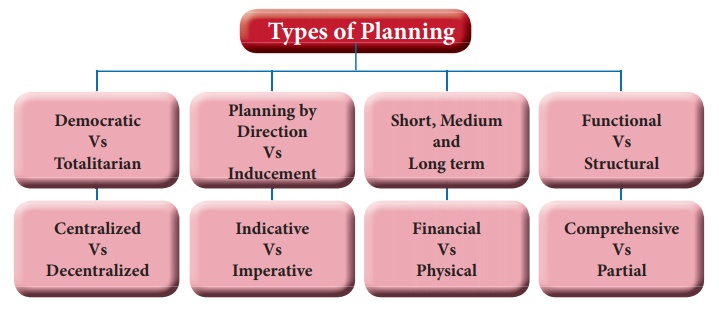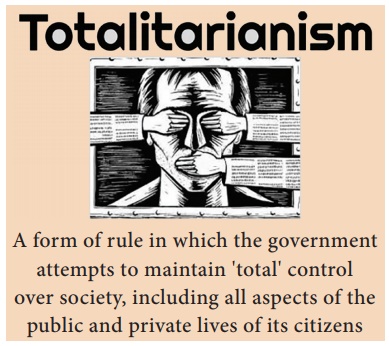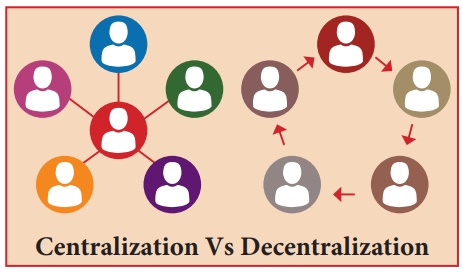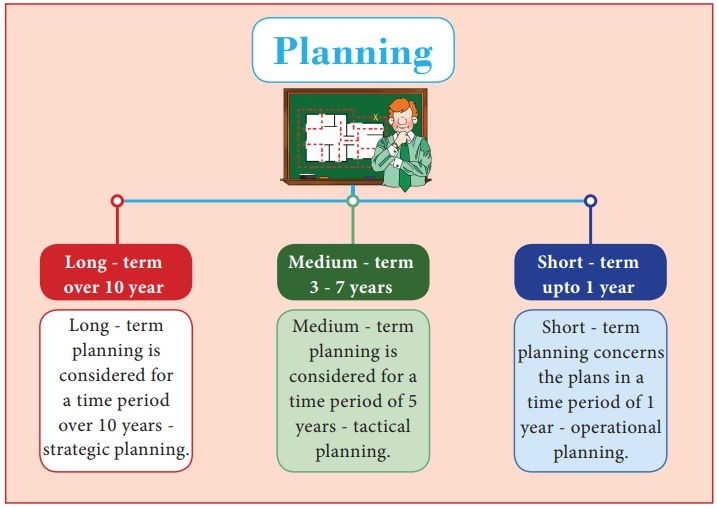Economics - Types of planning | 12th Economics : Chapter 11 : Economics of Development and Planning
Chapter: 12th Economics : Chapter 11 : Economics of Development and Planning
Types of planning
Types of planning

Economic planning is a process under which attempts are made to
achieve desired targets of economic development within a specified period of
time. There are different types of planning which differ in ideology and the
procedure in execution.
1. Democratic Vs Totalitarian:

Democratic planning implies planning within democracy. People are
associated at every step in the formulation and implementation of the plan. A
democratic plan is characterized by the widest possible consultations with the
various state governments and private enterprises at the stage of preparation.
The plan prepared by the Planning Commission is not accepted as such. It can be
accepted, rejected or modified by the Parliament of the country.
Under totalitarian planning, there is central control and
direction of all economic activities in accordance with a single plan.
Consumption, production, exchange, and distribution are all controlled by the
state. In authoritarian planning, the planning authority is the supreme body.
It decides about the targets, schemes, allocations, methods and procedures of
implementation of the plan.
2. Centralized Vs Decentralized: Under centralized
planning, the entire planning process in a country is under a central planning
authority. This authority formulates a central plan, fixes objectives, targets
and priorities for every sector of the economy. In other words, it is called
‘planning from above’.

Centralization Vs Decentralization
Under decentralized planning local organizations and institutions
formulate, adopt, execute and supervise the plan without interference by the
central authorities. In other words, it is called ‘planning from below’.
3. Planning by Direction Vs Inducement: Under planning by
direction, there is a central authority which plans, directs and orders the
execution of the plan in accordance with pre-determined targets and priorities.
Under planning by inducement, the people are induced to act in a
certain way through various monetary and fiscal measures. If the planning
authority wishes to encourage the production of a commodity, it can give
subsidy to the firms. Thus, planning by inducement is able to achieve the same
results as under planning by direction but with less sacrifice of individual
liberty.
4. Indicative Vs Imperative Planning: Indicative planning is
peculiar to the mixed economies. It has been in practice in France since the
Monnet Plan of 1947-50.
In a mixed economy, the private sector and the public sector work
together. Under this plan, the outline of plan is prepared by the Government.
Then it is discussed with the representatives of private management, trade
unions, consumer groups, finance institutions and other experts. The essential
function of planning is coordination of different economic units. The state
provides all types of facilities to the private sector. The private sector is
expected to fulfill the targets and priorities. The state does not force the
private sector but just indicate the areas of operation and targets to be
fulfilled. In short, the planning procedure is soft and flexible.
Under imperative planning, the state is all powerful in
preparation and implementation of the plan. Once a plan is drawn up, its
implementation is a matter of enforcement. The USSR President Stalin used to
say, ‘Our plans are our instructions’. There is complete control over the
entire resources by the state. There is no consumer sovereignty. The Government
policies and procedures are rigid. China and Russia follow imperative planning.
5. Short, Medium and Long term Planning: Short-term plans are
also known as ‘controlling plans’. They encompass the period of one
year, therefore, they are also known as ‘annual plans’.
The medium-term plans last for the period of 3 to 7 years. But
normally, the medium term plan is made for the period of five years. The
medium-term planning is not only related to allocation of financial resources
but also physical resources.

Long-term plans last for the period of 10 to 30 years. They are
also known as ‘perspective plans’. The basic philosophy behind long-term
planning is to bring structural changes in the economy.
6. Financial Vs Physical Planning: Financial planning
refers to the technique of planning in which resources are allocated in terms
of money while physical planning pertains to the allocation of resources in
terms of men, materials and machinery.
7. Functional Vs Structural Planning: Functional planning
refers to that planning which seeks to remove economic difficulties by
directing all the planning activities within the existing economic and social
structure.
The structural planning refers to a good deal of changes in the
socio-economic framework of the country. This type of planning is adopted
mostly in under developed countries.
8. Comprehensive Vs Partial Planning: General planning which
concerns itself with the major issues for the whole economy is known as
comprehensive planning whereas partial planning is to consider only the few
important sectors of the economy.
Related Topics